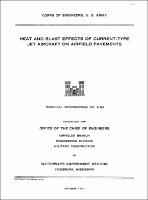Please use this identifier to cite or link to this item:
https://hdl.handle.net/11681/21294| Title: | Heat and blast effects of current-type jet aircraft on airfield pavements |
| Authors: | United States. Army. Office of the Chief of Engineers U.S. Army Engineer Waterways Experiment Station |
| Keywords: | Runways (Aeronautics) Blast effect Jet planes, Military |
| Publisher: | U.S. Army Engineer Waterways Experiment Station. Engineer Research and Development Center (U.S.) |
| Description: | Technical memorandum Preface: The tests reported herein cover a portion of the over-all "Study of Effect of Current-Type Jet Aircraft on Airfield Pavements,” set forth in Instructions and Outline, dated 2 August 1951, and addendum No. 1 thereto, dated 9 August 1951, by the Office, Chief of Engineers. The tests were authorized as a joint project, with operational phases assigned by U. S. Air Force to the Commanding General, Air Proving Ground, Eglin Air Force Base, Florida, and the engineering phases delegated by the Office, Chief of Engineers, to the Rigid and Flexible Pavement Laboratories of the Corp8 of Engineers. The Flexible Pavement Laboratory was responsible for over-all supervision of the project. The initial part of the operational phase, consisting of time-movement studies of jet aircraft at several operational airfields, was completed in November 1951 by the Air Proving Ground. A report summarizing the results was prepared by the Rigid and Flexible Pavement Laboratories ("Time-movement Study," January 1952). These time-movement studies served as a basis for establishing test procedures to simulate normal operation of all current-type jet aircraft used by U. S. Air Force. This report presents the results of small-scale field tests performed at Eglin Air Force Base, Florida, in 1952 to determine the effects of heat and blast, generated by various types of jet aircraft, on asphaltic-concrete and portland-cement-concrete pavements. 1Ihis report supersedes an "Interim Report on Heat and Blast Effects on Pavements," published by the Waterways Experiment Station in December 1952, wherein test results were summarized and made available for immediate use in the designing of pavements for jet aircraft. Messrs. J. C. Burton and F. L. Meara of the Directorate of Installations, U. s. Air Force, and Messrs. Gayle B. McFadden, T. B. Pringle, and W. C. Ricketts of the Office, Chief of Engineers, were active in the initial planning of this phase of the study. The South Atlantic Division Laboratory, Marietta, Georgia, tested construction materials and designed both the rigid and flexible pavement mixes. Contract for the construction of the test sections at Eglin Field was awarded to the Smith Engineering Company, Pensacola, Florida, by the Mobile District, Corps of Engineers. Mr. R. W. Davis, Resident Engineer for the Mobile District at Eglin Field, had immediate supervision of construction. Instrumentation and conduct of the tests for determination of heat and blast effects were under the direction of Lieutenant Colonel E. S. Airmet, Project Officer, Air Proving Ground, Eglin Air Force Base. Engineers of the Rigid Pavement Laboratory actively connected with the study were Messrs. F. M. Mellinger, B. U. Duvall, C. F. Renz, and W. w. Roberts; and of the Flexible Pavement Laboratory were Messrs. W. J. Turnbull, C.R. Foster, O. B. Ray, and E. C. Meredith. This report was prepared jointly by the Rigid and Flexible Pavement Laboratories. |
| Rights: | Approved for public release; distribution is unlimited. |
| URI: | http://hdl.handle.net/11681/21294 |
| Appears in Collections: | Technical Memorandum |
Files in This Item:
| File | Description | Size | Format | |
|---|---|---|---|---|
| WES-Technical-Memorandum-No.3-394.pdf | 5.59 MB | Adobe PDF |  View/Open |